The Cornell Lab Bird Academy › Discussion Groups › Nature Journaling and Field Sketching › Noticing Themes in Nature
-
 Spent about 20 minutes watching a Great Blue Heron on the S Platte River this morning. Watching him (or her?) I kept wondering how and where they sleep and if they are prey for all of the coyotes in this area.
It was interesting when I first sat down on the opposite shore, the heron immediately moved about 10 ft away and seemed very alert to my presence. By the time I got up to leave, I made a little noise but it didn’t seem to bother him at all.
Spent about 20 minutes watching a Great Blue Heron on the S Platte River this morning. Watching him (or her?) I kept wondering how and where they sleep and if they are prey for all of the coyotes in this area.
It was interesting when I first sat down on the opposite shore, the heron immediately moved about 10 ft away and seemed very alert to my presence. By the time I got up to leave, I made a little noise but it didn’t seem to bother him at all. -

-

-

-
Nice milk snake drawing! I think they are carnivorous: rodents insects, small invertebrates. Their name is a misnomer. But their patterns beautiful.
-
-
I have noticed over the past few years of observing birds in our yard that the small Inca quail have been pushed out while more and more white-winged and mourning doves have appeared. Eurasian collared doves have moved into our area, but not my yard yet, thankfully. However, I have observed rock doves (feral pigeons) moving steadily eastward in our valley. They used to congregate further to the west. A year ago I saw them in a neighbor's yard, less than a mile west of me. This year one found our feeders and now we get up to eight at a time. (I was surprised to see how big a pigeon appears next to a dove!). I wonder if the pigeon and larger dove habitats are expanding because they've been successful and need more room. Why did the Inca doves, once fairly regular visitors to my yard, disappear? Could they not compete with the larger doves? I've noticed how aggressive the larger doves are, especially to others of their species as well as the Gambel's quail. Did they drive the Inca doves away? Are the quail still successful because they stand their ground? Finches and sparrows are also smaller, but are holding (more than) their own, but the doves tend to ignore them. As I write, I hear the rather annoying sound of a white-winged dove driving another bird away. I'd like to figure out how to feed the Gambel's quail and not the doves!
-
Observation: In fall when leaves turn Burning Bush is a pale pink in 3 areas of my yard and bright red/pink at the end of the driveway. They are offshoots of the same plant so no difference in type/genus. Possible Explanations: Different soil make up with more of a particular nutrient to cause brighter color? Questions: What soil compositions affect color? Can it be added to other Burning Bushes to brighten color?
-
 A friend found this insect in the grass of the field that we were in today, we held and looked at if for a few minutes before it flew away.
I documented it in my nature journal when I got home, since I did not have it with me in this field today.
A friend found this insect in the grass of the field that we were in today, we held and looked at if for a few minutes before it flew away.
I documented it in my nature journal when I got home, since I did not have it with me in this field today. -
 It is foliage season in New Hampshire, dusk this time of year is interesting. I wonder why dusk seems so much brighter. Do yellow and orange leaves reflect the sunset better than green leaves?
I used pencil to sketch in some trees using some hatching practice, then used colored pencils in the same method to represent the foliage colors.
My dog and I walk the same nature path often, today there were not many birds. Do hawks hunt better when it is overcast? Most of the birds we saw kept to the lower shrubbery and under the leaves.
It is foliage season in New Hampshire, dusk this time of year is interesting. I wonder why dusk seems so much brighter. Do yellow and orange leaves reflect the sunset better than green leaves?
I used pencil to sketch in some trees using some hatching practice, then used colored pencils in the same method to represent the foliage colors.
My dog and I walk the same nature path often, today there were not many birds. Do hawks hunt better when it is overcast? Most of the birds we saw kept to the lower shrubbery and under the leaves. -
 There were over 100 sea gulls at the Lagoon
why so many birds?
perhaps there are a lot of fish in the Lagoon this year.
our summer was cooler this year, perhaps the fish were more abundant because of the higher water levels and cooler temperatures. More gulls because of more food
There were over 100 sea gulls at the Lagoon
why so many birds?
perhaps there are a lot of fish in the Lagoon this year.
our summer was cooler this year, perhaps the fish were more abundant because of the higher water levels and cooler temperatures. More gulls because of more food -
I liked your “report” as I enjoy looking at and trying to ID all birds and was told by a Serious Birder that gulls are great subjects to hone the art of seeing. They are plentiful (as you’ve noted), many of them sit still for long periods and perhaps most useful, there may be several different types (species?) in the same area which allows for comparisons to be made. I like to use binoculars and when appropriate, a small spotting scope for up-close observation. I really enjoy reading others’ entries after the chapters in this course. I wish some of the photos were clearer, it’s often hard to read what people wrote though like you, some type in the main notes. Thanks for uploading your pic and report.
-
-
We had a vary wet spring and summer. Now we have a super mast crop. We are also dealing with an outbreak of EEE and they are warning of a spike in tick borne illnesses this fall. Changes in weather patterns have many consequences for most systems. Changes in populations can affect many species, more ticks means fewer moose. More coyotes seems to mean fewer foxes. I find it interesting that bald eagles and ospreys are both recovering at the same time, which suggests that they have not yet reached carrying capacity of the fish population. (That is the most positive thing I’ve said in a long time.)
-
There seem to be fewer raptors/predators than prey. Knowing they are unsuccessful more often than not, how is the abundance of prey designed to help both predators and prey survive? Examples: dozens of frogs in a pond with one Great Blue Heron and one Green Heron; 30 or so Eastern Bluebirds in a flock with one Sharp-shinned Hawk zooming by; 12 squirrels in my back yard area but one pair of Red-shouldered Hawks raising one or 2 young.
Read More:
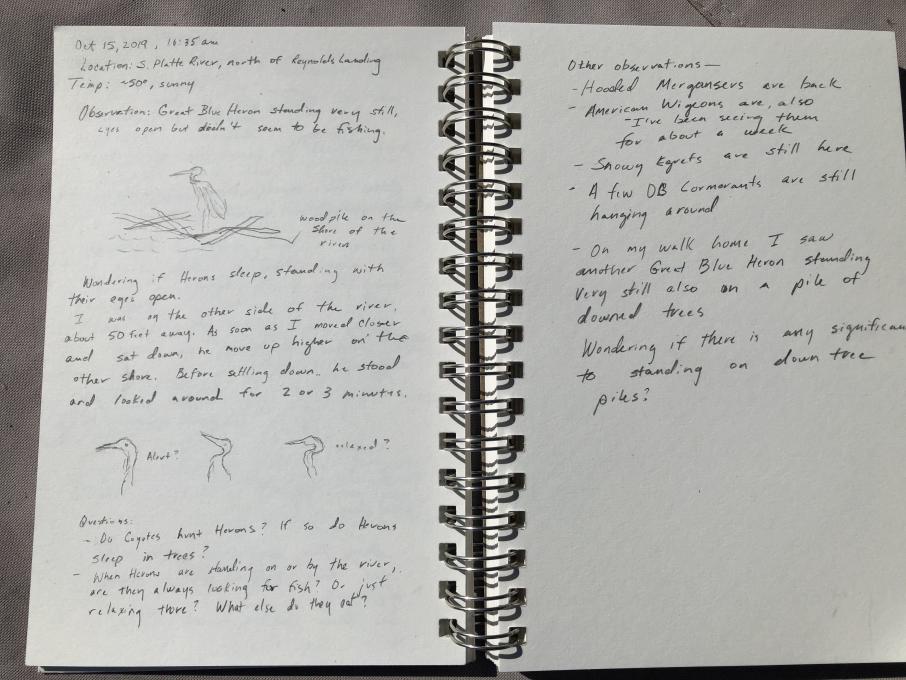 Spent about 20 minutes watching a Great Blue Heron on the S Platte River this morning. Watching him (or her?) I kept wondering how and where they sleep and if they are prey for all of the coyotes in this area.
It was interesting when I first sat down on the opposite shore, the heron immediately moved about 10 ft away and seemed very alert to my presence. By the time I got up to leave, I made a little noise but it didn’t seem to bother him at all.
Spent about 20 minutes watching a Great Blue Heron on the S Platte River this morning. Watching him (or her?) I kept wondering how and where they sleep and if they are prey for all of the coyotes in this area.
It was interesting when I first sat down on the opposite shore, the heron immediately moved about 10 ft away and seemed very alert to my presence. By the time I got up to leave, I made a little noise but it didn’t seem to bother him at all. 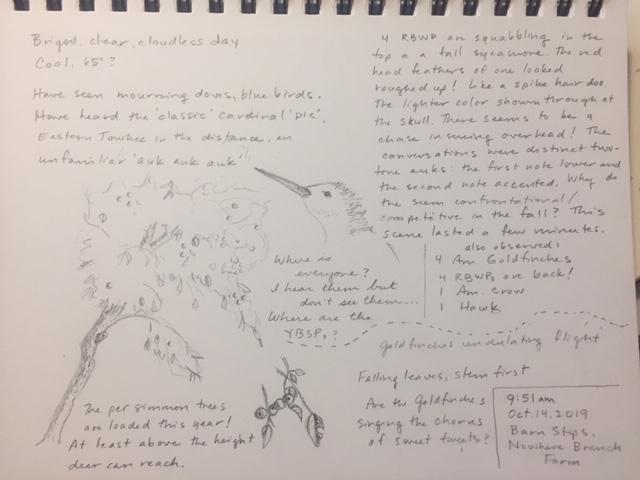
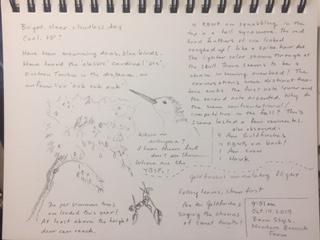
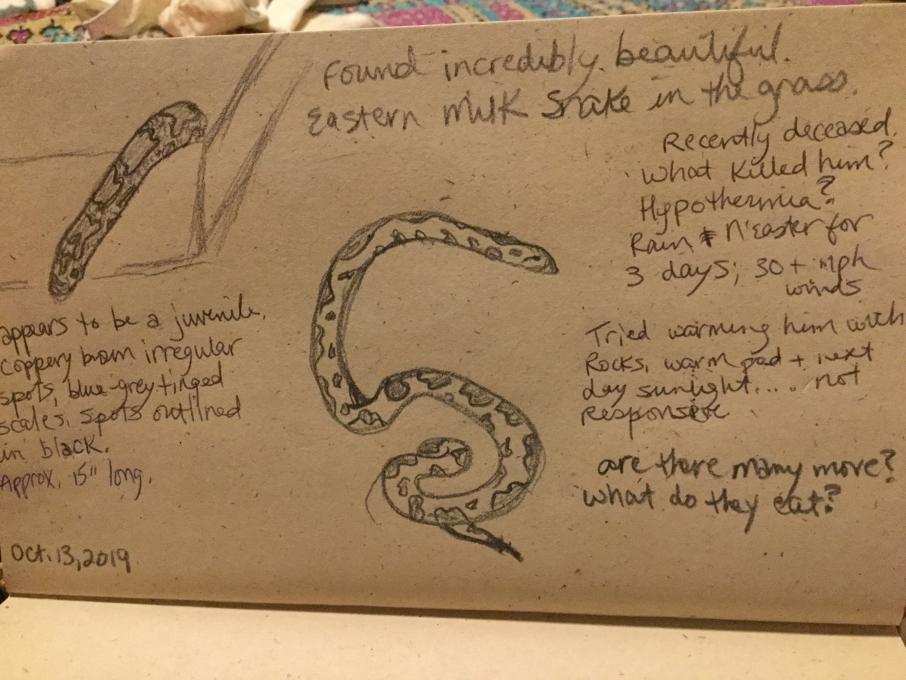
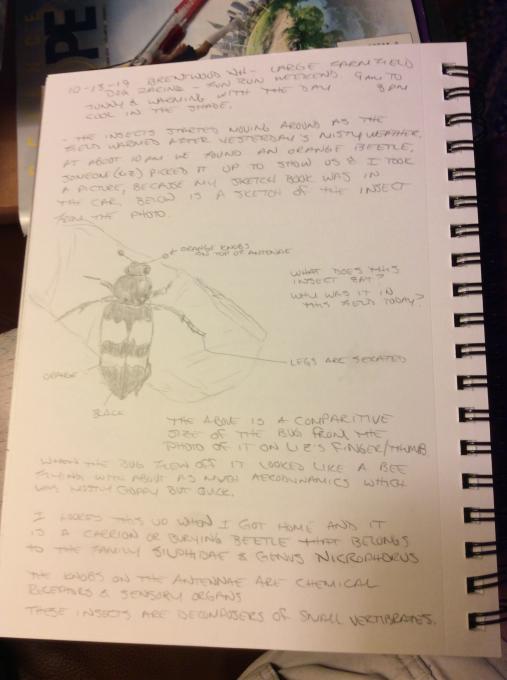 A friend found this insect in the grass of the field that we were in today, we held and looked at if for a few minutes before it flew away.
I documented it in my nature journal when I got home, since I did not have it with me in this field today.
A friend found this insect in the grass of the field that we were in today, we held and looked at if for a few minutes before it flew away.
I documented it in my nature journal when I got home, since I did not have it with me in this field today. 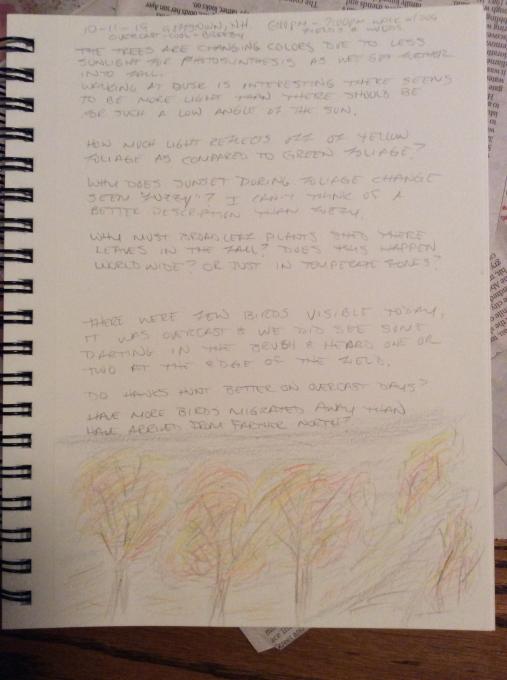 It is foliage season in New Hampshire, dusk this time of year is interesting. I wonder why dusk seems so much brighter. Do yellow and orange leaves reflect the sunset better than green leaves?
I used pencil to sketch in some trees using some hatching practice, then used colored pencils in the same method to represent the foliage colors.
My dog and I walk the same nature path often, today there were not many birds. Do hawks hunt better when it is overcast? Most of the birds we saw kept to the lower shrubbery and under the leaves.
It is foliage season in New Hampshire, dusk this time of year is interesting. I wonder why dusk seems so much brighter. Do yellow and orange leaves reflect the sunset better than green leaves?
I used pencil to sketch in some trees using some hatching practice, then used colored pencils in the same method to represent the foliage colors.
My dog and I walk the same nature path often, today there were not many birds. Do hawks hunt better when it is overcast? Most of the birds we saw kept to the lower shrubbery and under the leaves.  There were over 100 sea gulls at the Lagoon
why so many birds?
perhaps there are a lot of fish in the Lagoon this year.
our summer was cooler this year, perhaps the fish were more abundant because of the higher water levels and cooler temperatures. More gulls because of more food
There were over 100 sea gulls at the Lagoon
why so many birds?
perhaps there are a lot of fish in the Lagoon this year.
our summer was cooler this year, perhaps the fish were more abundant because of the higher water levels and cooler temperatures. More gulls because of more food